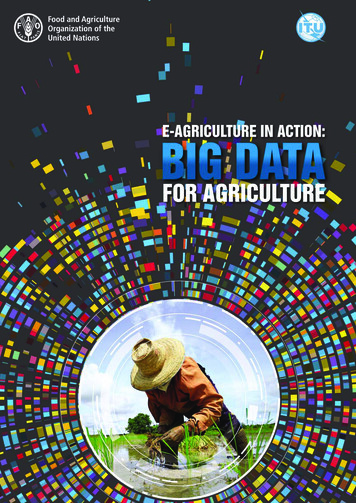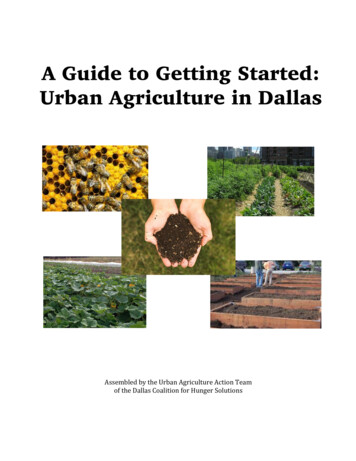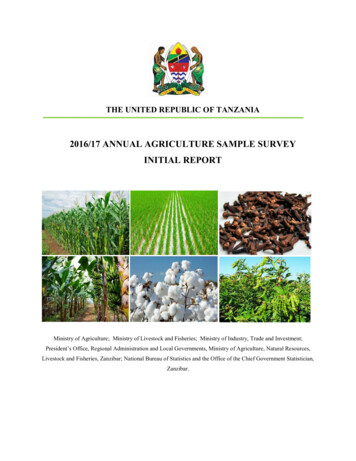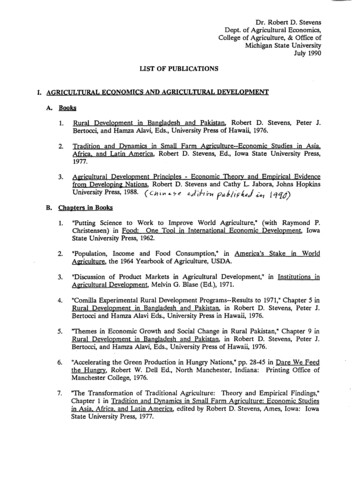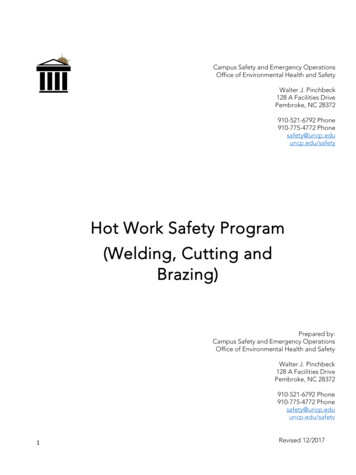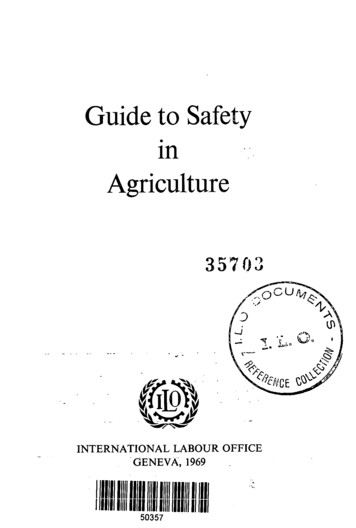
Transcription
Guide to SafetyinAgriculture35703INTERNATIONAL LABOUR OFFICEGENEVA, 1969I 111111111111111111111111111111111111111liii II Ii I hIll 11111111111 11111150357
ILO publications can be obtained through major booksellers or ILO local offices in many countries, or directfrom the International Labour Office (Sales Section),1211 Geneva 22, Switzerland. The catalogue and list ofbooksellers and local offices will be sent free of chargefrom the above address.PRINTED BY ATAR. GENEVA (SWITZERLAND)
FOREWORDThe present Guide to Occupational Safety in AgriculturalWork, whose publication was authorised by the Governing Bodyof the International Labour Office at its 155th Session (May-June1963), was drafted for the Office by Mr. H. RENNrUN of theSwedish Workers' Protection Board and finalised by a meeting ofexperts held in April-May 1964.'The guide was revised and given its present form in the lightof the views expressed and the amendments suggested by themeeting. The experts considered that it would have considerablevalue for economically advanced countries, but that it would beespecially useful for developing countries, and countries whereagricultural mechanisation was spreading rapidly.In particular they hoped that it would be consulted withadvantage by teachers in the field of agriculture, persons responsiblefor safety in large-scale and medium-scale agricultural undertakings, employers' and workers' organisations and public authorities and other interested bodies.1 The experts were as follows: Mr. Nikolai ANDREEV, Assistant Director,National Scientific and Technological Research Institute for the Repair andUse of Agricultural Machinery, Moscow; Mr. Jean BARTHELEMY, Centre ofStudies and Experimentation in Agricultural Machinery, Paris; Mr. G. B.FOGAM, General Secretary, Cameroon Development Corporation Workers'Union, Victoria, Cameroon; Mr. George HooK, Head of the Legal Department,National Union of Agricultural Workers, London; Mr. B. K. S. JAIN, VoltasLtd., Agricultural Machinery Division, Bombay; Mr. Lafayette W. KNAPP, Jr.,Chief of the Safety Section, Institute of Agricultural Medicine, State University of Iowa, Iowa City; Mr. A. MEIBOOM, Acting Chief Inspector of Labour,Ministry of Labour, Jerusalem; Mr. A. S. ØRSTED-MULLER (Chairman),Labour Inspectorate, Kolding, Denmark; Mr. Aboubakar Taha SHAALAN,Safety Engineer, Deputy Director of the Labour Department, Dakahlia,United Arab Republic.
IVGUIDE TO SAFETY IN AGRICULTUREThe International Labour Office published in 1967 a Code ofPractice on Safety and Health in Agricultural Work, which itprepared in collaboration with the same experts. It covers muchthe same ground as the guide, but its recommendations are expressed concisely in the form of rules, and it lacks explanatorymaterial and illustrations. It may perhaps be described as acondensed version of the guide and many readers may find it ahandy companion to the latter.The Office will publish a separate guide to occupationalhealth in agricultural work, and accordingly the present guide onlydeals in summary fashion with matters of health and hygiene.The Office realises that it may be venturesome to attemptto deal in one volume with all aspects of safety on all kinds offarms, but it feels that the guide, the work of an international bodyof experts, will help to preserve life and limb in a vital but, from theprevention point of view, rather neglected branch of economicactivity.
CONTENTSPageiiiForewordAccident Risks in Agriculture1Some General Principles4Farm Buildings889General RequirementsSiting of BuildingsConstruction of BuildingsStructural StrengthFire ProtectionFloorsFloor OpeningsWall OpeningsDoorsElevated WorkplacesStairsRunways and Bridges to Elevated StoreplacesRailingsSpace RequirementsHeating, Lighting, VentilationHygieneProtection against ral RequirementsNoticesTypes of sesSwitches, Plugs and SocketsConductorsLighting InstallationsFixed LampsPortable Lamps101010-3639
VIGUIDE TO SAFETY IN AGRICULTUREPageHeating InstallationsMotorsPortable and Transportable EquipmentElectric FencesTemporary Electricity SupplyMaintenance and Operation of Electrical Installations and AppliancesWork in the Vicinity of Live PartsTreatment of Electric Shock41Pressure VesselsSupervision and OperationPeriodic ExaminationSteam BoilersBoiler RoomsSafety DevicesBoiler AttendantsWater SupplyWater Level484949505050414243444445475051515252Starting UpSteam-heated Pressure Vessels (Steam Receivers)Low-pressure Steam BoilersWater HeatersFodder BoilersCold-water Pressure SystemsAir Receivers (Air Tanks)Compressed Gas CylindersPressure Sprayers52535353Driers, Silos, Stacks and PitsDriersCold-air DriersHot-air DriersGas-heated Driers57575757Silos54545959Grain SilosTower SilosHorizontal SilosEnsilage PitsHay and Straw StacksManure Pits616162Garages and Engine RoomsIsolation6565606262
VUCONTENTSPageVentilationHeating and LightingFloorsStorage of Flammable MaterialsSparks from WorkFire-fighting Equipment666767686868General Precautions with MachineryGuardsRemoval of GuardsDefective PartsStarting and StoppingEmergency StopsOperatorsOverspeedingMaintenance and Care of MachinesLoose ClothingWorking SpacesTransport of Machines and gines and TransmissionsEnginesFlywheelsWater-wheels and Water TurbinesInternal Combustion EnginesTransmissionsShaftingBelt DrivesGear-wheels8082Soil and Crop Preparation MachinesPloughsHarrowsRotary CultivatorsManure SpreadersSeed Drills83Harvesting MachinesGeneral PrecautionsMowers8989898991Rotary CuttersCombinesThreshing MachinesRakes8384858688.9297
VIIIGUIDE TO SAFETY IN AGRICULTUREPageChaff and Green-crop Cutters and BlowersBalers99Preparation of Fodder104105Some Other MachinesCross-cutting Log SawsWood-splitting MachinesBrush-cutting SawsRotary Lawn-mowersCentrifugesVentilating Fans108108108111113114TractorsRisksOverturning SidewaysOverturning BackwardsSafety Frame or CabPower Take-offBelt PulleyMudguardsExhaust PipeDriver's SeatTractors in Road TrafficFire HazardsSafety Rules for Tractor Drivers115115Other VehiclesFloors and SidesSeatsBrakesDrawbarsDump TrucksOperation of VehiclesFixed Hoisting and Transport AppliancesHoisting AppliancesInspection and TestingMarking ofSafe Working LoadDrums and Pulley BlocksBrakesLoose GearWire RopesFibre 131131132133135136137137138138138140140140140140
CONTENTSIXPageHand-operated WinchesOperating PrecautionsConveyorsSlat ConveyorsToothed ConveyorsExtension ConveyorsScrew ConveyorsBucket ElevatorsHand Tools, Implements and LaddersTools and 4154146146149General PrecautionsHorses155BullsAnimal-borne DiseasesWild AnimalsSnakesOther AnimalsInsects, etcDangerous SubstancesToxic SubstancesIngestionAbsorption through the SkinInhalationOxidising SubstancesPotassium NitrateSodium ChlorateQuicklimeFlammable LiquidsStorageFire-fighting19. Construction, Maintenance and RepairsMetalworking working MachinesCircular 68168169169170172---173173173174174175177177179
GUIDE TO SAFETY IN AGRICULTUREXPagePlanersCombined MachinesForgesWelding and CuttingThawing PipesScaffoldingWork on RoofsExcavations and Wells179181181183187187BlastingGeneral Precautions193193193193Transport, Storage and Handling of ExplosivesTransportStorageHandlingDrilling and Loading BoreholesFiringFiring with a FuseElectric FiringProtection of the VicinityAfter FiringMudblastsBlasting Tree StumpsDisposal of ire-fightingGeneral PrecautionsFire-fighting Equipment199199199Flammable Liquid FiresElectrical Equipment FiresWater SuppliesFire Alarm SystemsInstruction and TrainingForest and Field FiresRescuing 208The Importance of PostureManual OperationsWorkers Needing Special ProtectionImproving Uncomfortable PosturesDiseases and Morbid Conditions Caused by Incorrect WorkingPractices209
CONThNTSXIPageSome Other PrecautionsHousekeepingStorage of GoodsBurning StrawBurning WasteFirearmsPoultry Incubators and RearersArtificial Ripening of FruitShelter from Thunderstorms211211211212213213214214215Personal Protective EquipmentInstruction of WorkersControl of Personal Protective EquipmentHead ProtectionEye and Face ProtectionTypes and ApplicationsCare and MaintenanceRespiratory ProtectionTypes and ApplicationsCare and MaintenanceHand and Arm ProtectionSafety Belts and HarnessesTypes and ApplicationsCare and MaintenanceFoot and Leg ProtectionTypes and ApplicationsCare and MaintenanceWorking ClothesTypes and ApplicationsCare and 228229229231232232232First Aid233Farm Safety and Health OrgarnsationIndex235237ILLUSTRATIONSEducating the youngA modern lighting installation56Trap-door in floor with fire-resistant layer underneath and selfclosing fire-resistant coversFire-resistant roofing and partitions1112
XIIGUIDE TO SAFETY IN AGRICULTUREPage5; Fencing consisting of two rails and a toe-board14Floor opening in hayloft with device to prevent workers fromfalling through15Ways of securing doors1718Guards in wall opening above ground designed to fit a hoistingapparatusFixed ladder arranged for climbing on the inside to prevent fallsif the climber loses his holdSuitable angles and dimensions for ladders, stairs and ramps . .Single-rail fencing for stairs to a loading platformA runway constructed of stone and steelInsulated furnace roomLightning protectionHow to store a cableTwo fixed lamp installationsTwo hand-lampsHot-air grain drier equipped with water-heated radiatorRailings along horizontal silos to protect the tractor driver.Fixed guards for shaftsRotary cultivator properly designed and protectedSeed drill with operator's platform protected by rails, toe-board andwheel guardManure spreader with guarded moving parts24; Protection of a motor mowerA properly guarded rotary cutterAccess to a combine fitted with a handrail27. Examples of feed tables for end-feed threshersGuard for a floor opening above a feed opening of a machineGuard on horse-rakeSection through an old type of chaff cutterPower-driven wheel cutter with feed conveyorA roller cutter guarded above the fan outletGuard for a baler needleCross-cutting saw with rocking frameCross-cutting saw with roller tableBrush-cutting sawTractor fitted with a protective frameTractor fitted with a protective cabGuard for power take-off shaftAdjustable nip-point guard for belt pulleyAdjustable seat for tractor driverGuard protecting the points of a fork-lift when not in use .The driver's seat on a horse-driven vehicleThree designs for 8100101103106109110112119120122123125126132134
CONTENTSXIIIPageA rotatable support for a raised dump-truck platformChain and hook with maximum safe load marked on a tabNip-point guards on pulley blocksGuards on tools to prevent hand injuriesKnuckle guards fitted to the handles of a wheelbarrowTwo hammersScrewdriver bitsA storage rack for agricultural implementsGuards for the transport of sharp-edged or pointed toolsLadders of conventional constructionDoor of a bull's boxBull's nose-ring and leading staffLeading a bullILO danger symbolsOperating a grinding-wheelCircular sawBand-saw with wheel guard openedGuards for overhand planerTruck-mounted welding equipmentScaffolding of sound constructionSafety in roof-climbingA fire-fighter in actionGood lifting practicesA commonly used type of safety 78180182184188190201208230
1.ACCIDENT RISKS IN AGRICULTURE1.1. Throughout the world several hundred million personsare employed in agriculture. It has been estimated that from75 to 100 million of them are accounted for by India alone.Nearly30 per cent of the population of Japan live on farms and some15 million persons work on them (1960). Agriculture, in fact, is theworld's largest industry.1.2. We do not know how many accidents happen every yearin the world's agriculture. But the number is certainly very large,and there is evidence that agriculture is in many respects a dangerous activity. The cost of accidents is twofold; there is the costin money and the cost in suffering.1.3. The cost in money is accounted for by medical treatment,compensation, loss of output, loss of wages, damage to buildings,machinery and other property, and so on. A fire may cause onlyslight injuries to a worker but it may do a very great deal of damageto property.1.4. In terms of human costs an accident to a farm handmay be a very serious matter for him and his family. On afamily farm, where the livelihood of the family depends on thefarmer's ability to work, a fatal accident or an accident thatdisables him for several weeks may be catastrophic.1.5.Accidentsfatal, serious and minoroccur on allkinds of farms and related agricultural and forestry undertakingscattle farms, fruit farms, wheat farms, vineyards and others. Evenflower growers have been killed or permanently disabled byaccidents at work. Moreover, accidents spare neither the veryyoung nor the very old; every year large numbers of boys andgirls, old men and old women are injured on the farms of the world,and thousands of them are permanently disabled or even killed.
GUIDE TO SAFETY IN AGRICULTURE21.6. The farm worker's natural environment presentsnumerous risks for him. He may be threatened by land, water,sun or wind. Disasters have been caused by floods, landslidesand avalanches. Marshes may be a source of malaria and earthpolluted by refuse a source of infectioncases of tetanus, ankylostomiasis and helminthic diseases still occur. Water from streamsand wells is often not fit to drink. Lightning is a bigger risk in thecountry than in towns. In summer there may be a risk of sunstroke, and in winter of frostbite. In some regions wild animalssuch as wolves and bears are risks; others are infested by snakes orinsects such as scorpions and tarantulas; and in others againthere are poisonous plants such as poison ivy and poison oak.The farmer's own animals contract diseases and communicate themto man. Thus there is plenty of scope for accident prevention andhealth protection.1.7. Farm workers' living conditions are outside the scopeof this manual, but for the large numbers who live in caves, hutsand cabins in different parts of the world life is certainly unhealthy,if not actually unsafe.1.8.activities.Agricultural work embraces a very wide range ofAlthough the main activities are the cultivation ofcrops and the raising of livestock, on a modern farm or plantationa considerable amount of work may be involved in processingproduce and in the maintenance and repair of buildings, plant,machinery and implements. It may be necessary also to generateelectricity, dig wells, maintain irrigation systems, clear land, buildroads, undertake drainage works, run sawmills and transportheavy loads of produce to the market. Many of these activitiesinvolve the use of machinery and other equipment, which if notproperly handled and safeguarded may cause serious accidents.In others, the use of pesticides and other dangerous substances willthreaten the health of workers. In fact, in all agricultural activitiesthere will be some kind of accident risk. The general trend inagriculture is to rely more and more on machines, electricity andchemicals to do the work, and the occupational risks are in consequence bearing a closer resemblance to those in other industries.
ACCIDENT RISKS IN AGRICULTURE31.9. It will be clear, then, that in an industry so large and socomplex as agriculture, the prevention of accidents is of the greatestimportance: if frequency and severity rates could be substantiallylowered throughout the world, the whole agricultural populationwould reap a rich reward. The purpose of this guide is to suggestsome ways and means of achieving progress towards greater safetyon the farm. It will be seen that it is not only necessary to providesafe equipment and safe working conditions; everyone working onfarmsfarmers, foremen, specialists, labourers and the restmust possess the necessary training and education to enable themto keep the work safe.
2. SOME GENERAL PRINCIPLES2.1. There are a few general principles of accident preventionthat apply to all industries, and not only to agriculture. It may beuseful to recall them at the beginning of this guide, if only becauseall that follows is based upon them.2.2. The overriding principle is certainly that of placing themain responsibility for the safety of workpeople on the employer,here the farmer. Some countries have laws and regulations, andeven inspectors, for the protection of farm workers, but laws andregulations cannot provide for every contingency, and inspectors,where there are any, cannot usually spend more than a few hoursin a year at any one farm. The day-to-day work of promoting andmaintaining safety has to be done by the employer or under hisdirection.2.3. To begin with, when acquiring machines, appliances,vehicles or other equipment, the farmer should ensure that theyshould conform to any safety regulations or standards applyingto them.2.4. As regards the actual work, the farmer should providesuch supervision as may be needed to keep his workpeople reasonably safe. Good supervision is particularly important with newworkers.2.5. The workers themselves need to be properly instructedin the hazards of their jobs and the precautions that they shouldtake (fig. 1). Here again particular care must be taken with newworkers. A worker who cannot recognise dangerous conditions,or who does not know how to do ajob safely, is a danger to himselfand to others. Safety education and training are therefore of vitalimportance. In fact, ignorance of danger can lead to very seriousaccidents. There have been cases where workers in a locality
SOME GENERAL PRINCIPLES5Fig. 1. Educating the young.Young people's safety training is a valuable preparation for their future.have been poisoned by pesticides because they had no idea thatthey were dangerous. Employers are usually required to post upcopies or summaries of national or local regulations, as well asappropriate instructions and notices, relating to protection againstaccidents and injuries to health.2.6. Often rules are drawn up by manufacturers concerningprecautions to be taken in the handling, operation and maintenanceof equipment, e.g. in instruction books for machinery and on labelsand containers for toxic substances. It is very important that allsuch rules should be obeyed.2.7.Naturally workers as well as employers have dutiesin the domain of safety. One is to make proper use of all safeguards and other appliances, etc., furnished for their protectionand the protection of others. Such means of protection should notbe interfered with, altered, removed or displaced without proper
6GUIDE TO SAFETY IN AGRICULTUREFig. 2. A modern lighting installation.authorisation, and should never be wantonly damaged. Otherfundamental duties of workers are to conform to all safety andhealth instructions relating to their work, and to refrain fromdangerously careless or reckless behaviour. Before beginning
SOME GENERAL PRINCIPLES7work they should examine their workplaces and the equipmentthat they are to use, and should promptly report to their foremanor employer any dangerous conditions that they may find. Ifnecessary to prevent an accident the use of the workplace or equip-ment should not be permitted until matters have been put right.2.8. Restrictions on the employment of women and adolescents may be necessary or at least advisable. No young personthe notion of "young" will vary from one part of the world toanothershould be employed on particularly dangerous worksuch as attending power-driven machinery, driving tractors,handling bulls, handling flammable liquids in unsealed containers,working with explosives, operating steam boilers or working withpoisonous or corrosive substances.2.9. Lighting is important (fig. 2). Places where lighting isrequired for the safety of workers, near moving machinery forinstance, should be efficiently lighted, either naturally or artificially,as long as any workers are around.2.10. Tidiness is also important. All places in farm buildingsand yards where work is carried on, or people have to pass, shouldbe kept clear of rubbish and obstructions that might cause slipping,falling or stumbling.
FARM BUILDINGS3.1. A good part of the farm worker's life is spent in buildings of one sort or anotherliving quarters, barns, stables, silos,garages, etc.so it is important that farm buildings should be safeand healthy places to work in. Unfortunately they often are not:the statistics of some countries show that up to a quarter of allfarm accidents take place in buildings. Some of these accidentsare no doubt caused by bad working practices, but many are theresult of faulty design or bad maintenance, or both. Much ruralill-health may also be ascribed to defective farmhouses or otherliving quarters.live in.Large numbers of farm workers have no houses to3.2. Among the dangerous and unhealthy conditions thatcan be found in farm buildings are dirt, disorder, overcrowding,poor drainage, accumulation of garbage, neglected walkways,insufficient headroom, poor ventilation, darkness, floors unevenand in bad repair, lack of fire precautions, and rickety stairs andladders.GENERAL REQUIREMENTS3.3. Farm buildings should be designed, constructed andequipped so as to provide good working conditions and reduceas far as is practicable risks such as fires, collapse of structures,falls of objects and falls of persons.3.4.When new farm buildings are planned the followingmatters should be given special consideration:(a) siting, with a view, for instance, to avoid having a line ofbuildings in the direction of the prevailing wind, which wouldfacilitate the spread of fire;
FARM BUILDINGS9structural strength, soundness and safety (load-bearingcapacity, protection against falls, fire hazards, etc.);layout from the point of view of transport and means ofaccess to storeplaces and working areas;space requirements for storage and working;heating, lighting and ventilation;hygiene (sanitation);protection against lightning.3.5.In many countries there are national regulations orlocal by-laws concerning the planning and construction of farmbuildings. When awarding contracts for new buildings orsubstantial alterations or repairs to existing buildings, farmerswould do well to stipulate that the buildings, alterations or repairsshould conform to any relevant safety regulations, or, if there arenone, that they should conform to national or other recognisedstandards; if appropriate the competent authority should beconsulted. Advice can also be obtained from other qualifiedpersons such as consultants and building surveyors.3.6 It is not enough simply to erect buildings that complywith safety requirements. They have to be maintained in a safecondition. If any dangerous condition is found in floors, steps,galleries, stairs, hatches, etc., it should immediately be remedied,or access to the place concerned should be prevented.SITING OF BUILDINGSAs already suggested, useful precautions against fireIn addition to alayout at right angles to the direction of the prevailing wind, ameasure of insulation may be desirable. A concrete or masonrysilo placed between two buildings acts as a fire-resisting barrier.3.7.can be taken by suitable siting of farm buildings.
10GUIDE TO SAFETY IN AGRICULTURECoNsmuCTIoN OF BUILDINGSStructural Strength.3.8.All buildings, permanent or temporary, should bestructurally safe so as to be free from any risk of collapse, and theroofs should be able to withstand normal stresses due to snow, ice,wind and rain, and, where necessary, to carry suspended loads.Advantages of single-storey buildings are that the absence ofstairways, ladderways and floor openings reduces the risk ofaccidents by falls, and the buildings can more easily be designedto prevent the spread of fire.Fire Protection.3.9.Whenever possible fire-resistant materials should beused in the construction of buildings (fig. 3).The fire-resistance ofwooden structures can be increased by covering the wood withcement, asbestos cement sheets, iron or steel sheets or compressedrubble. A sheet-steel construction has a high resistance to fire, andpreferable to wooden construction, provided that climaticconditions do not make the building too hot or too cold and somake work fatiguing. Impregnated wood can be used in newisbuildings, but it should be periodically reimpregnated.3.10. Wooden floors in existing buildings can usually bemade more fire-resistant at small cost by providing a covering ofbricks or stamped clay, but if this is done care must be taken thatthe load on the floor is not excessive.3.11. Maçiy buildings have storage space for readily combustible materials. Cattle sheds, for example, may have a hayloft. In such cases it is particularly important to provide fireresistant insulation for the storage space. Ventilating shafts incattle sheds should be provided with fire-resistant covers thatautomatically close when a fire breaks out (fig. 3).3.12. Roof coverings should be of fire-resistant materialssuch as tiles, slates, asbestos-cement sheets or sheet steel (fig. 4).
Fig. 3.Trap-door in floor with fire-resistant layer underneath and seIfcloslngfire-resistant covers.
00EC0C000a00000Cau.a2C0CEo o-2 000o2EU.cu:r00E00-C0C00
13FARM BUILDINGS3.13.Access to upper floors and elevated workplaces inbuildings should, as far as practicable, be by means of stairs andnot ladders. There should always be stairs leading to upper floorsto which workers have to go regularly.FLOORS3.14. Floors and other walkway surfaces should be sufficientlyfirm, continuous and even to afford safe walking, and, if necessary,safe transport of materials.3.15. In particular, they should be free from holes, splinters,improperly fitted covers for gutters and conduits, protruding 'nailsand bolts, projecting valves or pipes, or other projections orobstructions that might constitute stumbling hazards.3.16. Except for drainage purposes in wet places such asdairies, floors should be level as far as practicable. If a slopingfloor is necessary it should not slope down towards an openingin a wall or floor.3.17. Floors and walkway surfaces should be non-slippery;if necessary they can be roughened. Floor coverings and planksshould be securely fixed to prevent tilting pr displacement.3.18. Gaps between floor planks should be avoided, but ifthey are necessary they should be as narrow as practicable and in nocase exceed 2 in (5 cm).3.19. The maximum load per unit of area to be carried byany floor of a storeplace and the maximum permitted load ofany vehicle used on such floor should be clearly indicated on anotice.'Makeshift additional floors should be avoided as far aspracticable and in any case should be laid only in storeplaces' suchas barns.3.20.''FLOOR OPENINGS3.21. Ladderway, stairway, hatchway and other floor oryard openings accessible to persons should be guarded on all
U.U,U.
FARM BUILDINGS15Floor opening In hayloft with device to prevent workers from falling through.The heIght of the guard should be 4 ft (1.2 m).FIg. 6.exposed sides by permanent or removable railings or covers orother effective means (fig. 5).3.22. If the guard is removed to allow the passage of personsor goods it should be replaced immediately afterwards.3.23.Floor openings must be protected by railings andtoe-boards so as to prevent persons and objects falling into them.If materials such as hay or straw are stacked so high and storedso close to an opening that railings would afford no protectionagainst falls, the opening should be protected by a device such
16GUIDE TO SAFETY IN AGRICULTUREas an elevated cover (fig. 6). Covers over manholes and otherfloor openings should be of substantial construction, safe to walkon and capable of supporting the weight of any vehicle likely topass over them. Wherever possible they should be hinged;otherwise they should be securely fixed in position, to preventaccidental displacement.3.24. Openings in fire-resistant floors, as in haylofts, mustalways be kept closed by fire-resistant means when not in use.Openings in floors for. sack hoists and similar installations shouldbe provided with covers which close automatically after the passageof the sack.WALL OPENINGS3.25.Wall openings less than 40 in (1 m) from the floor andmeasuring at least 30 in (75 cm) vertically and 18 in (45 cm)horizontally, from which there is a drop of more than 5 ft (1.5 m),should be protected to a height of at least 40 in (1 m) by rails(fig. 7), fences, doors or other effective means. Narrower wallopenings should be protected by a toe-board if their lower edgeis less than 6 in (15 cm) from the floor. If the protection ofopenings at least 30 in (75 cm) wide is removable an adequatehand-grip should be fixed on each side, or an adequate bar shouldbe placed across the opening at chest height.DooRs3.26. Doors that are opened and closed vertically should beprovided with effective counterbalance weights or other effectivedevices to prevent them from inadvertently opening or closing oraccidentally falling down. All doors and gates should be providedwith effective means to prevent them from sliding or being liftedoff their hinges (fig. 8).
FARM BUILDINGS17Fig. 7. Guards in wall opening above ground designed to fit a hoisting apparatus.The floor Is filled with a toe-board.
Fig. 8. Ways of securing doors.A. Hooks. B. Latches. C. Stop applied above a hinge. D. Stop applied belowa hinge.
sity of Iowa, Iowa City; Mr. A. MEIBOOM, Acting Chief Inspector of Labour, Ministry of Labour, Jerusalem; Mr. A. S. ØRSTED-MULLER (Chairman), . Maintenance and Operation of Electrical Installations and Appliances 44 Work in the Vicinity of Live Parts 45 Treatment of Electric Shock 47 Pressure Vessels 48 Supervision and Operation 49

